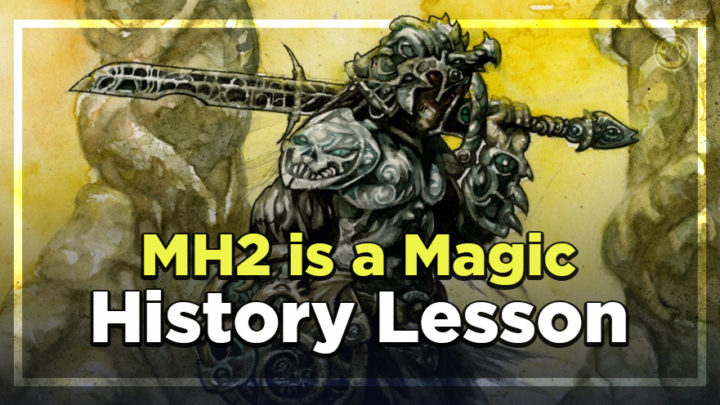Few sets in Magic have ever been as highly anticipated as Modern Horizons 2. The passionate reactions to each day’s spoilers show as much — people have figured out that these Horizons sets are special, that no longshot reprint or kooky keyword portmanteau is off limits.
When you dangle hope in front of players who had long since given up on their pet deck getting direct support again, you awaken a powerful expectation. And while each niche design has been celebrated by its audience, the rest of the Magic player base is left to ask: “Who’s Dakkon? Where is this octopus lady from? Why is that card name fifteen syllables long?”
Some more veteran folks might remember hearing about these “new” characters in passing, or spotting the name in some flavor text at the Commander table. In fact, Commander fans may even know the original in-game incarnation of Dakkon Blackblade, from the infamous Legends set which originally helped inspire that format.
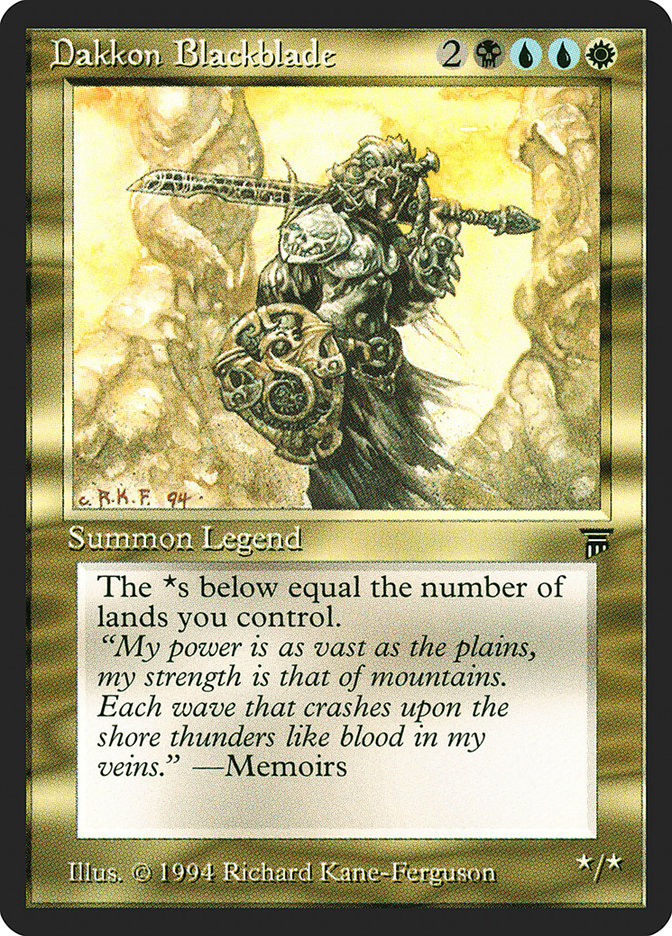
But that still leaves too many questions for a modern fan. Who are these planeswalkers, really – just someone’s old D&D characters? Out of all the legends in Legends, what makes these ones legendary enough that they get to hog a whole Modern Horizons set — a set where WotC could have printed literally anything and gotten away with it!?
Dakkon Blackblade turns out to be the key to all of it. His lengthy backstory is a little bit The Princess Bride, and a little bit Elric of Melnibone — a classic dark fantasy anti-hero with a tragic, yet sympathetic arc. It was a story told largely through Magic’s tie-in comic book in the mid-90’s, a time when WotC was still experimenting with how to build a larger fictional universe around the concepts from their trading card game. Though later retcons would wind Dakkon’s saga into the long-running canon of Nicol Bolas and the Gatewatch, at the time, the big bad villain of choice was a demoness named Geyadrone Dihada.
DIHAD’TA DO IT TO HIM
Throughout these comics, Geyadrone appeared as a corruptive, manipulative mastermind — the kind who reveals that your plan was actually their plan all along; who never fights, but simply dupes her enemies into battling each other for her ultimate benefit.
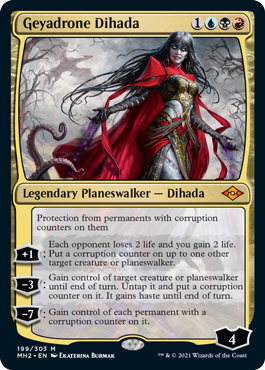
She started messing with Dakkon over 5,000 years back in Magic’s hazy timeline. He was a mortal warrior and weaponsmith when the demoness showed up at his door, offering Dakkon the deal of a lifetime. All he had to do was forge the mightiest magical sword that would ever exist: the Blackblade. In return, Geyadrone Dihada promised to grant Dakkon himself the godlike power of a planeswalker! Of course, it’s nearly certain that Dakkon was already possessed of a strong planeswalker spark — why would this demonic being rely on a random mortal to craft such a weapon? But alas, a random mortal couldn’t have known that at the time, and so Dakkon became obsessed with the idea of creating the perfect sword.
Dakkon’s labors to create the Blackblade lasted ten years and involved not only work at the forge, but much study and travel to gather the arcane secrets required to create the ultimate weapon. Starting out as merely an exceptional swordsmith, Dakkon’s hunger for perfection drove him to become a master of dark rituals and forbidden magic. He began working his own blood into the Blackblade, in order to cultivate the soul-consuming abilities Dihada had requested. But eventually Dakkon realized his sacrifice alone would not be enough. He murdered his own son, Daron, binding the boy’s innocent soul to the Blackblade as a rite of dedication. Dakkon went on to feed the sword thousands more slaves over the years, killing one every night to quench the blade after working it.
Of course, this maniacal drive to complete the Blackblade was precisely what Dihada had hoped to induce all along. Corrupting Dakkon down this dire path was far more valuable to the demon planeswalker than any mere sword — even the most powerful one in the Multiverse. Her long con had always been to sculpt this nascent planeswalker into a perfect warrior, a general for her demonic army of conquest.
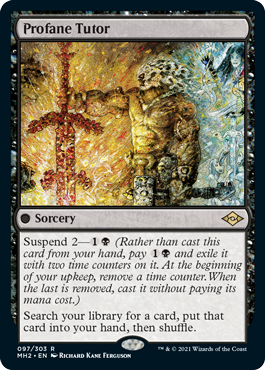
Just like the fable of Inigo Montoya’s father from The Princess Bride, Geyadrone eventually returned for the blade Dakkon had given up everything to create — and betrayed him. She granted Dakkon untold power — and, at the same moment, stole his soul and his shadow away into the Blackblade, leaving him to wander incomplete and alone among the planes.
It was through this wandering that Dakkon would connect to another major thread of this early Magic story — the Carthalion line of heroes. If you were confused by the fanfare around Jared Carthalion’s appearance in Commander Legends, this is also his origin story!
A BOY NAMED CARTH
Some years later, Geyadrone Dihada’s forces laid waste to a Dominarian town named Carth, leaving a single young man alive to seek revenge in its name. Though he was quickly captured by her corrupted legions, “Carth” would get a second chance. One of his fellow prisoners helped him to escape with knowledge of a ritual which could summon the great and terrible planeswalker Dakkon Blackblade. Since Dakkon had also sworn revenge against Dihada, Carth assumed the swordsman would be a natural ally.
But this was all another twisted scheme by Dihada, who had decided it was time to recall Dakkon from his roaming among the planes and corrupt him completely into her eternal general. It was Geyadrone herself who, disguised, assisted Carth in his escape; his honest desire for revenge was the bait which would draw the wandering Dakkon into her clutches. Everything since the destruction of Carth’s village had merely been one chess move in her millennia-long plan to entrap the Blackblade and its wielder.
Dakkon was forced to fight desperately against Dihada’s minions to avoid this fate, with the demon seemingly always a step ahead. Despite being forced to receive Dihada’s mark, Dakkon survived the battle and became a mentor to the man he dubbed “Carth the Lion,” who went on to found the heroic bloodline Jared Carthalion would later inherit.
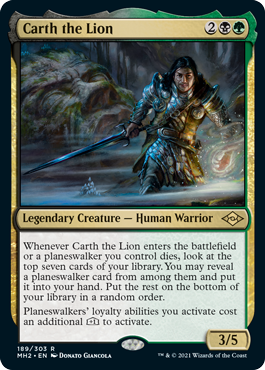
AS USUAL, BOLAS RUINS EVERYTHING
As for the Blackblade itself, that would survive on Dominaria for years, taken up by the hands of many evil champions as befits a soul-drinking sword. Without Dakkon’s skilled care, it deteriorated, which led to it being reforged. It would eventually come to rest in the vaults of Demonlord Belzenlok’s Cabal, but this would lead to his undoing when the Gatewatch realized the sword’s legendary origins made it capable of destroying him.
And so, the Blackblade fell into the hands of its final wielder: Gideon Jura. The incorruptible and indestructible white planeswalker wielded the weapon to noteworthy success both against Belzenlok and Nicol Bolas’s army during the War of the Spark, immune to the malign influence of its magic. However, the Blackblade would still be Gideon’s undoing. When he tried to wield it against Bolas himself, the sword abruptly shattered. Bolas had studied Dakkon’s ancient victory over Piru the Volatile and sought out the weapon long ago to sabotage this potential dragon-slaying threat.
Or perhaps he had merely substituted the Blackblade for a forgery, rather than reforging it to hold a critical flaw. Because now it seems the legendary Dakkon Blackblade is still at large in the Multiverse, and he certainly doesn’t seem to be without his signature blade!
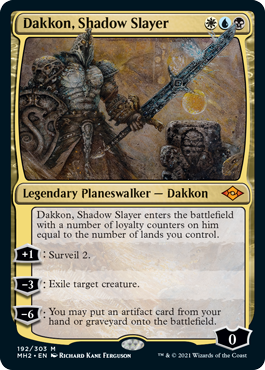
THE LORE IS FOR ALL OF US
So, it turns out the planeswalkers of Modern Horizons 2 actually have some of the most intricate backstories in the game’s canon! Still, you could argue that calling back to a comic tie-in from 1996 like this is overly nostalgic. Considering the average Magic player is probably younger than those comics, what’s the point in going back to give them fanservice twenty-five years later? Surely the kids would be more excited to buy MH2 boxes if the mythics showed newer faces like Fblthp, or Mileva of the Tenth, or Alesha?!
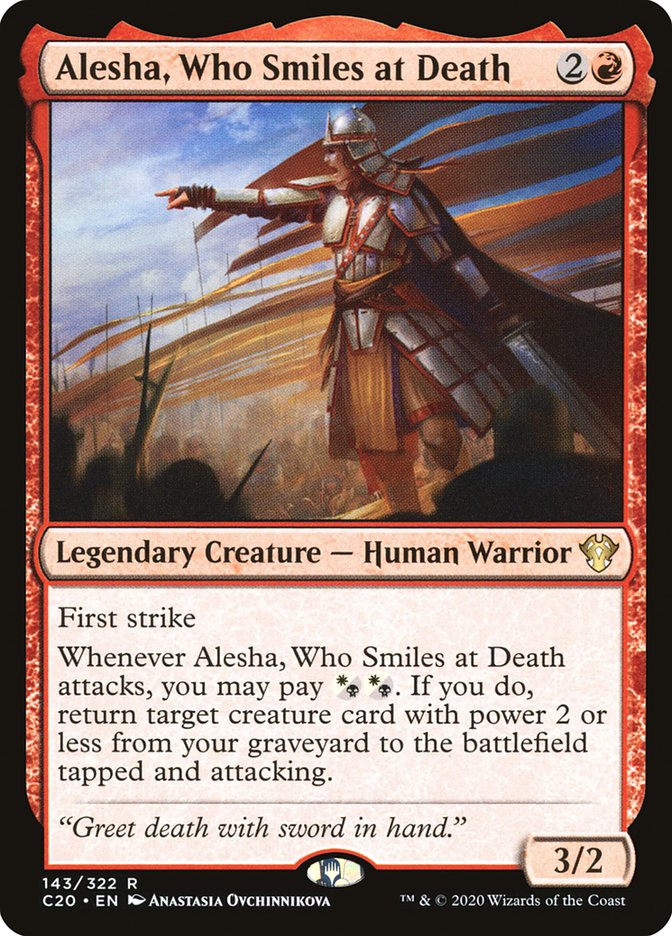
But after thinking about it, I’m convinced that this deep-cut Dakkon nostalgia is just as valuable for the teenagers in the Magic crowd as it is for the forty-somethings. The past the characters of Legends represent is one of the most unique selling points Magic has: no competitor can boast this rich, textured buildup of lore, one which itself helps show the evolution of the game, the people making it, and who it was made for.
It’s been observed that on Magic Online, where card prices are no barrier, Magic’s youngest generation are absolutely enthralled by historical formats like Legacy and Vintage, often competing against the “paper boomers” for tournament bragging rights. I’m certain that part of the mystique is simply the weight of history present in the card pool; the opportunity to witness almost thirty years of iterative game design within the course of a single match. As Magic players, even newer ones, it’s natural to take pride and interest in the heritage of the game. And by re-introducing these old characters to the 2021 player base, WotC is inviting us all to share in that nostalgia. These characters were obscure favorites of a few venerable greybeards — but now they will belong to everyone.

Tom’s fate was sealed in 7th grade when his friend lent him a pile of commons to play Magic. He quickly picked up Boros and Orzhov decks in Ravnica block and has remained a staunch white magician ever since. A fan of all Constructed formats, he enjoys studying the history of the tournament meta. He specializes in midrange decks, especially Death & Taxes and Martyr Proc. One day, he swears he will win an MCQ with Evershrike. Ask him how at @AWanderingBard, or watch him stream Magic at twitch.tv/TheWanderingBard.

